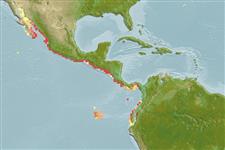Actinopterygii (ray-finned fishes) >
Perciformes (Perch-likes) >
Polynemidae (Threadfins)
Etymology: Polydactylus: Greek, poly = a lot of + greek, daktylos = finger (Ref. 45335).
Environment / Climate / Range
Ecology
Marine; demersal; depth range 10 - 60 m (Ref. 91172). Subtropical, preferred ?; 34°N - 7°S, 118°W - 77°W (Ref. 57343)
Eastern Pacific: Los Angeles Harbor in California, USA to off Paita, Peru; rare north of Baja California, Mexico.
Size / Weight / Age
Maturity: Lm ? range ? - ? cm
Max length : 50.0 cm TL male/unsexed; (Ref. 55763); common length : 25.0 cm TL male/unsexed; (Ref. 55763)
Dorsal
spines
(total): 9;
Dorsal
soft rays
(total): 11-13;
Anal
spines: 3;
Anal
soft rays: 12 - 14. Body and fins yellowish; no stripes or spots. Anterior parts of lower jaw with villiform teeth extending onto lateral surface, adjacent part of lip poorly developed in large specimens. Vomerine teeth present. Maxilla covered with small deciduous scales. Pectoral filaments 9. Lateral line unbranched, extending to upper end of caudal fin lobe. Swim bladder absent (Ref. 45049).
Inhabits coastal waters and estuaries, on sand and mud bottom (Ref. 9332). Also found along sandy beaches (Ref. 57343). Esteemed food fish in the tropical eastern Pacific (Ref. 57343).
Life cycle and mating behavior
Maturity | Reproduction | Spawning | Eggs | Fecundity | Larvae
Motomura, H., S. Kimura and Y. Iwatsuki, 2002. Revision of the threadfin genus Polydactylus (Perciformes, Polynemidae) from the eastern Pacific Ocean. Ichthyol. Res. 49(4):358-366. (Ref. 45049)
IUCN Red List Status (Ref. 115185)
CITES (Ref. 94142)
Not Evaluated
Threat to humans
Harmless
Human uses
Fisheries: minor commercial
More information
ReferencesAquacultureAquaculture profileStrainsGeneticsAllele frequenciesHeritabilityDiseasesProcessingMass conversion
Tools
Special reports
Download XML
Internet sources
